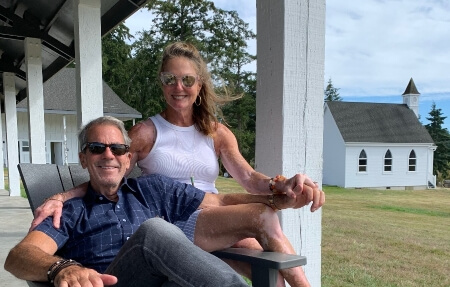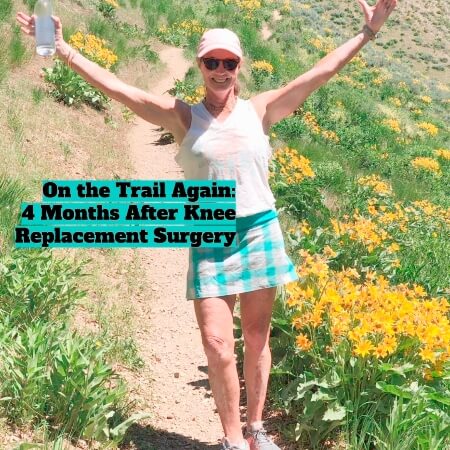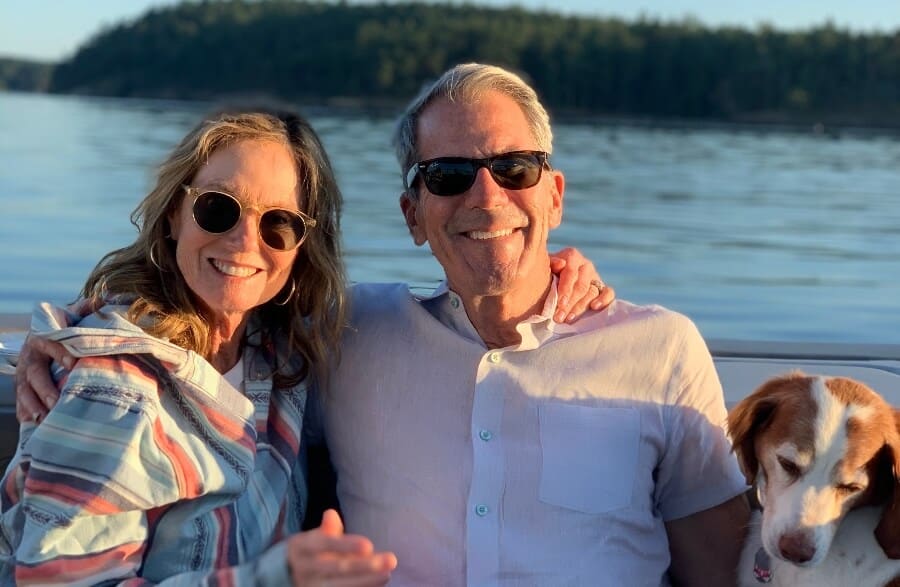This article is the third of a three-part series sponsored by DePuy Synthes and the ATTUNE®Knee System.
In almost every way, Laurie Barrett’s knee replacement story sounds familiar. She was happily going about her very active life, when in her early 60s, she was increasingly forced to give up her favorite pursuits like working out, because she couldn’t stand her knee pain any longer. The important difference in Laurie’s experience is that she is married to her junior high school sweetheart, Bill. But to the world, Bill is Dr. Barrett, a renowned orthopaedic surgeon who specializes in joint replacement and one of the original surgeons that contributed to the design of the ATTUNE® Knee System.
Laurie’s story, paired with the knowledge and insight of Bill, who has performed thousands of knee replacement surgeries, offers unique insight on what to expect with knee replacement surgery and the recovery process that follows.
“I’d never been there to see the progression of a patient from surgery to recovery,” says Bill, who practices at Proliance Orthopedic Associates in Renton, Washington. “It was eye-opening.”
Laurie sees how they’ve both benefitted from her procedure. “I’ve gotten my life back,” she says. “And it has really made him a better doctor, as the husband of a total joint recipient. He’s just expanded his knowledge of what this takes.”
Read More: For This Active Woman, 2 Knee Replacements Mean Life is Once Again a Day at the Beach
Dwindling Quality of Life
For 35 years as an exercise instructor, Laurie had been motivating others to work up a sweat and helping others find the joy of movement. But at some point, there stopped being joy for her. Just pain. She started teaching spin classes because, she says, she couldn’t jump around the room like she used to. Then it hurt too much to stand up on the bike. “I finally had to stop teaching,” she says. “Here I’d been the person at the front of the room, up and down and do this and do that, and people would say you’re the fittest 65-year-old I’ve ever met. When you don’t have that, you start to doubt yourself. I was getting depressed.”
Even worse was not being able to get down on the floor to play with her grandchildren. “Just trying to get up, I felt like a beached whale.” There were also safety issues; her knee was so unstable she fell often. “At one point, when I’d tripped too many times, I said we’ve got to do something about this,” she reports.
Though her husband was sympathetic, he wasn’t sure at first that she was ready for knee replacement. He reports that the metrics for determining when the time is right have changed. Formerly, it was whether or not someone could walk three to five miles, which Laurie could do. But he soon realized that a better measure was when a patient had increasing pain and decreasing function.
“Laurie’s quality of life was shrinking and shrinking,” he says.
Researching a Surgeon
How convenient it would have been for Laurie to simply have her husband do her knee replacement surgery, but hospitals have conflict of interest policies that prevent surgeons operating on family members. Luckily, Bill knew where Laurie should go for her procedure.
For the rest of us, finding the best surgeon takes more work. Bill emphasizes how important it is to ask the right questions and research the right surgeon for you, such as: How many surgeries have you done? Do you track your results? What are your rates of infection and dislocation?
“Patients are afraid of hurting a surgeon’s feelings, but these are things that are important to know,” he says. “You want your knee to last you for the next 20 to 25 years, so investing time into research is key to improving your outcomes.”
Getting the Right Device for You

In 2006, Bill, along with other top orthopaedic surgeons from around the world, was invited to develop a new knee system for DePuy Synthes, a Johnson & Johnson Company. The surgeons worked together with DePuy Synthes engineers to create the ATTUNE Knee, a state-of-the-art knee replacement system. “What we came up with is a curve that continuously changes throughout the arc of motion,” he reports. “That’s what builds the stability into the knee replacement.”
With extensive research and data over a six-year-span, the system was modified and tested over and over until the researchers felt it was right. “The results were incredibly gratifying,” he says.
Bill had no doubt the ATTUNE Knee was right for Laurie. “At the end of day, you help come up with this design, and then you see it put into your wife and it comes full circle,” he says.
Team Recovery
Fear of the unknown is the main reason people put off knee replacement surgery, according to Bill, who is doing his part to help solve that issue. After Laurie’s surgery he wrote several blog posts that detail the day-to-day progress and challenges they experienced. “It helps to have a sense of what this journey is going to look like and what the milestones are,” he says. An example of an entry: “Day three was met with feeling bummed out, questioning the logic of having a knee replacement, and frustrated with the lack of real progress. Those are all normal feelings and, with the support of friends and family, these feelings fade and you press on.”
Bill reports that the fourth or fifth day is peak for pain and swelling, and when he was helping Laurie, he planned something special—an appointment for a facial—to get her over that hump. He also lays out the milestones Laurie met, so that others can get a better idea of what to expect. Laurie used a walker full-time in week one; by week two she had started using a cane, but was still using a walker for longer walks. At week three, she was using the cane outside, but relying on furniture and walls for balance inside. After a month, she was walking independently with a small limp and at week six, she took a 3.5 mile walk with a minimal limp.
Laurie worked diligently with a physical therapist, starting on day three, and set goals for herself. “I’m tough; I grew up in the era of Jane Fonda. No pain, no gain,” she says. “Each week I’d tick off a little more to get through. You’ve got to get that range of motion. Of course, it helped having my husband at home harping on me, `Did you do this today, did you do that?’”
Read More: Osteoarthritis Knee Pain? Here’s How One Bad-ass Got Back to Living
The Life of a Caregiver
Over his 35-year career, Bill has seen a lot, but still wasn’t quite prepared for the demands of being a caregiver after a total knee replacement surgery. “Obviously, I knew that over the six to eight weeks after surgery it wasn’t all fun and unicorns, but now I have a whole new perspective,” he says. “The first week is a full-time job for both patient and caregiver.” Bill took the first week off work to help Laurie, and admits he thought he might have a bit of downtime to read, but this was far from the case. “Every hour during the day, you have to get the patient to ice and elevate and then get them up to walk around and do range-of-motion exercises,” he says.
Now, he is able to use his experience to advise caregivers on what to expect. “I tell them it’s an investment in the patient, a team effort. You’re driving them to therapy, being a cheerleader, encouraging them when they get down,” Bill says. “It’s such an important thing; the caregiver has to be dialed in.”
Feeling Right Again

Laurie has had a few a-ha moments since the surgery, moments when she realizes that her new knee is all she could hope for. A recent nine-mile hike with her husband was easier than she expected. “There were roots all over the trail, which was partly in shadows. I caught my toe on a root, and my knee didn’t shift out of place at all. It held,” she reports. “The confidence that it gives me is amazing. Everything feels right.”
It’s satisfying for her husband to hear this, knowing that this is what the ATTUNE Knee was designed to do. And in many ways, Laurie’s recovery and results continue to surprise him. Recalling a family ski trip eight months after Laurie’s surgery, he confesses that, worried for her, he followed behind her on the slope to keep an eye out on her. “I was paranoid thinking something was going to happen,” he says. “When she asked why was I skiing behind and I told her, she said she wasn’t even thinking about her knee. I thought that was so significant.”
In addition to the physical freedom she experienced, Laurie has felt new emotional highs. She has been truly proud to see that after being at his side through medical training, her husband’s work can make such a difference. “My enthusiasm is back. It’s translated into my relationship with my husband, with our kids.” And, she says, with her young grandson. For so long she had not been able to pick him up because of her knee pain. “My biggest thrill came one day when I surprised him at preschool,” she says. “He was so excited and he came running at me and just jumped in my arms. Then he pushed back and said, “Lala, you’re holding me, you’re picking me up.’ It was the first time in a long time. I thought `WOW.’”
Important Safety Information:
It’s important to remember that the performance of knee replacements depends on age, weight, activity level and other factors. There are potential risks and recovery takes time. People with conditions limiting rehabilitation should not have these surgeries. Only an orthopedic surgeon can determine if knee replacement is necessary based on an individual patient’s condition.





















0 Comments